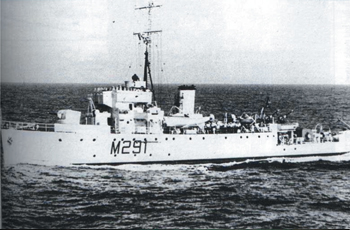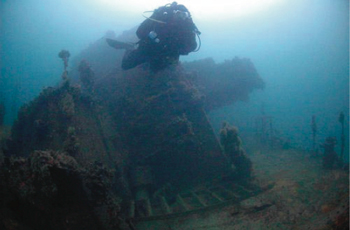 |
 |
| Then |
Now |
Technical specs
- Algerine class minesweeper
- Keel laid down: 8 October 1942 at Lobnitz and Co. Renfrew, Scotland
- Launched: 18 June 1943
- Completed: 7 October 1943
- Displacement: 1330 tonnes fully loaded
- Length overall: 68.6m.
- Beam: 10.8m
- Draft: 3.5m.
- Maximum speed: 16 knots
- Powered by: two 3-drum boilers supplying two 4-cylinder triple expansion steam engines and twin screws.
- Indicated power: 2400Hp.
- Range: 5500 miles at 10 knots.
HMS Pelorus, an Algerine class minesweeper, was launched in Scotland in 1943. The Algerine class was designed for multi-purpose use, incorporating the lessons learned during the long war. They were large enough to accommodate equipment for detecting contact, acoustic and magnetic mines and as well as for detecting submarines. The Pelorus was, most appropriately, named after a dolphin called Pelorus Jack, which was famous for guiding ships through a dangerous sea passage off the New Zealand coast between 1888 and 1912. Like the dolphin before it, the Pelorus was mainly involved in convoy duty, but in the cold waters of the north Atlantic.
Its moment of glory came as the lead ship of the Normandy D-Day invasion in 1944. For eleven days, the Pelorus and other minesweepers kept the aproaches to the beaches clear of mines, despite heavy daily shellfire from onshore gun batteries and nightly bombing by Luftwaffe planes. When helping clear the harbour at Cherbourg, the Pelorus was struck by a mine which lifted the ship right out of the water. There were no human casualties, but the ship had to spend three months under repair. No doubt Pelorus Jack, which survived an attempted shooting in 1904, would have approved.
Though other ships of the Algerine class continued with minesweeping duties well after the war, the Pelorus was sold to the South African Navy in 1947 and renamed the SAS Pietermaritzburg. As the Pietermaritzburg, the ship was used rather more mundanely as a training vessel and minesweeper. It was decommissioned for the final time in 1964 and then used as accommodation for the Mine Countermeasures squadron from 1968 to 1991.
After some debate as to its possible future as a maritime museum, the Pietermaritzburg was scuttled by explosives in late 1994 to form an artificial reef. The wreck initially lay upright on the sand, and was used for extensive penetrations. There has been one fatality on the wreck: a commercial diver on a training course, who, along with his buddies, got lost inside the ship. They ended up in a cabin and all managed to escape via a porthole apart from one man, who was too big to get out and drowned there. A very sobering testament to the perils of treating overhead environments with anything less than utter respect.
Fifteen years underwater off the Cape of Storms have left their mark on the PMB. It has been seriously damaged by winter storms - the most notable being the storm of late August 2008, which twisted the deck out of true and left the ship with a distinct list.
Further damage was done by the storm of June 2009, which ripped the bridge off the ship. It can now be seen lying alongside the main wreck. There are still possible penetrations that can be done, but the ship plating is rather fragile in places and looks unstable, so the smart money is on staying outside the wreck.
Ref: africandiver.com